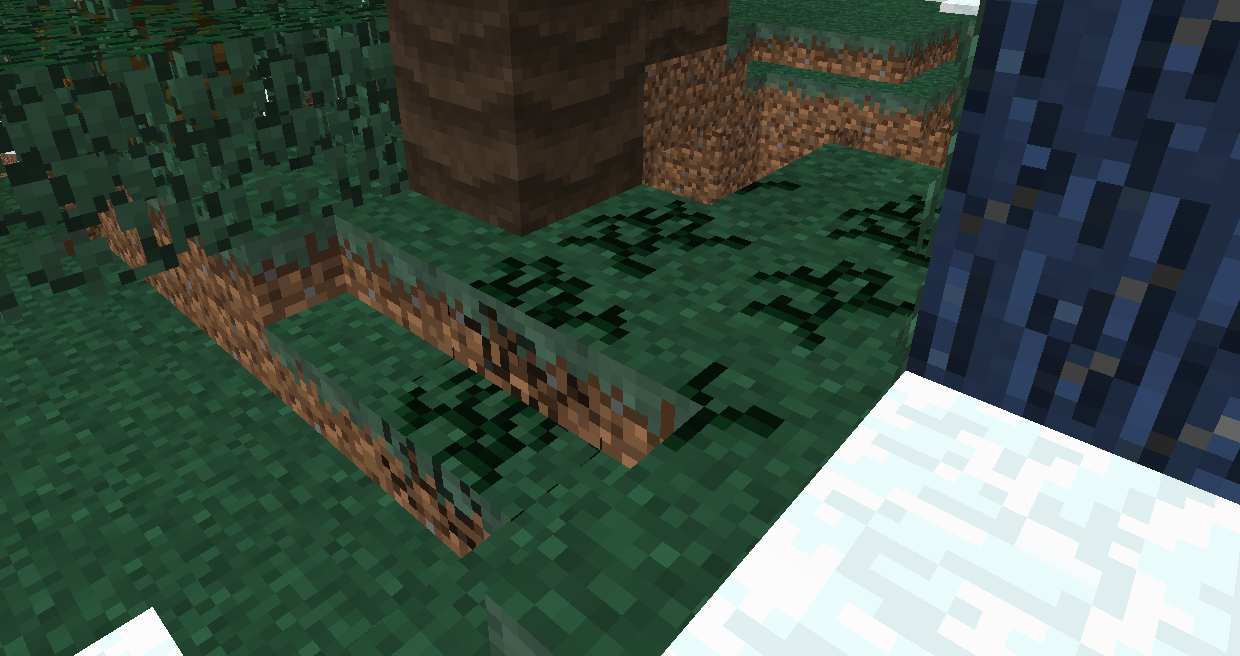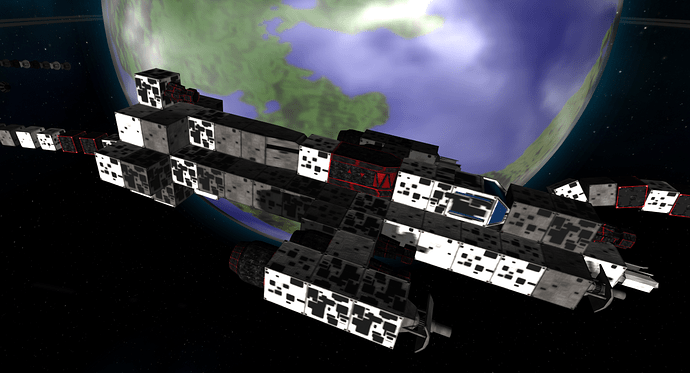Sorry, to bother you about this now (I didn’t have time to try it out before) but I seem to get a compilation error on the frag shader:
WARNING: Bad compile of:
1 #define DIFFUSEMAP 1
2 #define DIFFUSEOVERLAY 1
3 #define NORMALMAP 1
4 #if (defined(PARALLAXMAP) || (defined(NORMALMAP_PARALLAX) && defined(NORMALMAP))) && !defined(VERTEX_LIGHTING)
5 vec2 steepParallaxOffset(sampler2D parallaxMap, vec3 vViewDir,vec2 texCoord,float parallaxScale){
6 vec2 vParallaxDirection = normalize( vViewDir.xy );
7
8 // The length of this vector determines the furthest amount of displacement: (Ati's comment)
9 float fLength = length( vViewDir );
10 float fParallaxLength = sqrt( fLength * fLength - vViewDir.z * vViewDir.z ) / vViewDir.z;
11
12 // Compute the actual reverse parallax displacement vector: (Ati's comment)
13 vec2 vParallaxOffsetTS = vParallaxDirection * fParallaxLength;
14
15 // Need to scale the amount of displacement to account for different height ranges
16 // in height maps. This is controlled by an artist-editable parameter: (Ati's comment)
17 parallaxScale *=0.3;
18 vParallaxOffsetTS *= parallaxScale;
19
20 vec3 eyeDir = normalize(vViewDir).xyz;
21
22 float nMinSamples = 6.0;
23 float nMaxSamples = 1000.0 * parallaxScale;
24 float nNumSamples = mix( nMinSamples, nMaxSamples, 1.0 - eyeDir.z ); //In reference shader: int nNumSamples = (int)(lerp( nMinSamples, nMaxSamples, dot( eyeDirWS, N ) ));
25 float fStepSize = 1.0 / nNumSamples;
26 float fCurrHeight = 0.0;
27 float fPrevHeight = 1.0;
28 float fNextHeight = 0.0;
29 float nStepIndex = 0.0;
30 vec2 vTexOffsetPerStep = fStepSize * vParallaxOffsetTS;
31 vec2 vTexCurrentOffset = texCoord;
32 float fCurrentBound = 1.0;
33 float fParallaxAmount = 0.0;
34
35 while ( nStepIndex < nNumSamples && fCurrHeight <= fCurrentBound ) {
36 vTexCurrentOffset -= vTexOffsetPerStep;
37 fPrevHeight = fCurrHeight;
38
39
40 #ifdef NORMALMAP_PARALLAX
41 //parallax map is stored in the alpha channel of the normal map
42 fCurrHeight = texture2D( parallaxMap, vTexCurrentOffset).a;
43 #else
44 //parallax map is a texture
45 fCurrHeight = texture2D( parallaxMap, vTexCurrentOffset).r;
46 #endif
47
48 fCurrentBound -= fStepSize;
49 nStepIndex+=1.0;
50 }
51 vec2 pt1 = vec2( fCurrentBound, fCurrHeight );
52 vec2 pt2 = vec2( fCurrentBound + fStepSize, fPrevHeight );
53
54 float fDelta2 = pt2.x - pt2.y;
55 float fDelta1 = pt1.x - pt1.y;
56
57 float fDenominator = fDelta2 - fDelta1;
58
59 fParallaxAmount = (pt1.x * fDelta2 - pt2.x * fDelta1 ) / fDenominator;
60
61 vec2 vParallaxOffset = vParallaxOffsetTS * (1.0 - fParallaxAmount );
62 return texCoord - vParallaxOffset;
63 }
64
65 vec2 classicParallaxOffset(sampler2D parallaxMap, vec3 vViewDir,vec2 texCoord,float parallaxScale){
66 float h;
67 h = texture2D(parallaxMap, texCoord).a;
68 #ifdef NORMALMAP_PARALLAX
69 //parallax map is stored in the alpha channel of the normal map
70 h = texture2D(parallaxMap, texCoord).a;
71 #else
72 //parallax map is a texture
73 h = texture2D(parallaxMap, texCoord).r;
74 #endif
75 float heightScale = parallaxScale;
76 float heightBias = heightScale* -0.6;
77 vec3 normView = normalize(vViewDir);
78 h = (h * heightScale + heightBias) * normView.z;
79 return texCoord + (h * normView.xy);
80 }
81 #endif
82 #ifdef SPHERE_MAP
83 #define ENVMAP sampler2D
84 #define TEXENV texture2D
85 #else
86 #define ENVMAP samplerCube
87 #define TEXENV textureCube
88 #endif
89
90 // converts a normalized direction vector
91 // into a texture coordinate for fetching
92 // texel from a sphere map
93 vec2 Optics_SphereCoord(in vec3 dir){
94 float dzplus1 = dir.z + 1.0;
95
96 // compute 1/2p
97 // NOTE: this simplification only works if dir is normalized.
98 float inv_two_p = 1.414 * sqrt(dzplus1);
99 //float inv_two_p = sqrt(dir.x * dir.x + dir.y * dir.y + dzplus1 * dzplus1);
100 inv_two_p *= 2.0;
101 inv_two_p = 1.0 / inv_two_p;
102
103 // compute texcoord
104 return (dir.xy * vec2(inv_two_p)) + vec2(0.5);
105 }
106
107 vec4 Optics_GetEnvColor(in ENVMAP envMap, in vec3 dir){
108 #ifdef SPHERE_MAP
109 return texture2D(envMap, Optics_SphereCoord(dir));
110 #else
111 return textureCube(envMap, dir);
112 #endif
113 }
114 #define ATTENUATION
115 //#define HQ_ATTENUATION
116
117 varying vec2 texCoord;
118 #ifdef SEPARATE_TEXCOORD
119 varying vec2 texCoord2;
120 #endif
121
122 varying vec3 AmbientSum;
123 varying vec4 DiffuseSum;
124 varying vec3 SpecularSum;
125
126 #ifndef VERTEX_LIGHTING
127 uniform vec4 g_LightDirection;
128 //varying vec3 vPosition;
129 varying vec3 vViewDir;
130 varying vec4 vLightDir;
131 varying vec3 lightVec;
132 #else
133 varying vec2 vertexLightValues;
134 #endif
135
136 #ifdef DIFFUSEMAP
137 uniform sampler2D m_DiffuseMap;
138 #endif
139
140 #ifdef DIFFUSEOVERLAY
141 uniform sampler2D m_DiffuseOverlay;
142 #endif
143
144 #ifdef SPECULARMAP
145 uniform sampler2D m_SpecularMap;
146 #endif
147
148 #ifdef PARALLAXMAP
149 uniform sampler2D m_ParallaxMap;
150 #endif
151 #if (defined(PARALLAXMAP) || (defined(NORMALMAP_PARALLAX) && defined(NORMALMAP))) && !defined(VERTEX_LIGHTING)
152 uniform float m_ParallaxHeight;
153 #endif
154
155 #ifdef LIGHTMAP
156 uniform sampler2D m_LightMap;
157 #endif
158
159 #ifdef NORMALMAP
160 uniform sampler2D m_NormalMap;
161 #else
162 varying vec3 vNormal;
163 #endif
164
165 #ifdef ALPHAMAP
166 uniform sampler2D m_AlphaMap;
167 #endif
168
169 #ifdef COLORRAMP
170 uniform sampler2D m_ColorRamp;
171 #endif
172
173 uniform float m_AlphaDiscardThreshold;
174
175 #ifndef VERTEX_LIGHTING
176 uniform float m_Shininess;
177
178 #ifdef HQ_ATTENUATION
179 uniform vec4 g_LightPosition;
180 #endif
181
182 #ifdef USE_REFLECTION
183 uniform float m_ReflectionPower;
184 uniform float m_ReflectionIntensity;
185 varying vec4 refVec;
186
187 uniform ENVMAP m_EnvMap;
188 #endif
189
190 float tangDot(in vec3 v1, in vec3 v2){
191 float d = dot(v1,v2);
192 #ifdef V_TANGENT
193 d = 1.0 - d*d;
194 return step(0.0, d) * sqrt(d);
195 #else
196 return d;
197 #endif
198 }
199
200 float lightComputeDiffuse(in vec3 norm, in vec3 lightdir, in vec3 viewdir){
201 #ifdef MINNAERT
202 float NdotL = max(0.0, dot(norm, lightdir));
203 float NdotV = max(0.0, dot(norm, viewdir));
204 return NdotL * pow(max(NdotL * NdotV, 0.1), -1.0) * 0.5;
205 #else
206 return max(0.0, dot(norm, lightdir));
207 #endif
208 }
209
210 float lightComputeSpecular(in vec3 norm, in vec3 viewdir, in vec3 lightdir, in float shiny){
211 // NOTE: check for shiny <= 1 removed since shininess is now
212 // 1.0 by default (uses matdefs default vals)
213 #ifdef LOW_QUALITY
214 // Blinn-Phong
215 // Note: preferably, H should be computed in the vertex shader
216 vec3 H = (viewdir + lightdir) * vec3(0.5);
217 return pow(max(tangDot(H, norm), 0.0), shiny);
218 #elif defined(WARDISO)
219 // Isotropic Ward
220 vec3 halfVec = normalize(viewdir + lightdir);
221 float NdotH = max(0.001, tangDot(norm, halfVec));
222 float NdotV = max(0.001, tangDot(norm, viewdir));
223 float NdotL = max(0.001, tangDot(norm, lightdir));
224 float a = tan(acos(NdotH));
225 float p = max(shiny/128.0, 0.001);
226 return NdotL * (1.0 / (4.0*3.14159265*p*p)) * (exp(-(a*a)/(p*p)) / (sqrt(NdotV * NdotL)));
227 #else
228 // Standard Phong
229 vec3 R = reflect(-lightdir, norm);
230 return pow(max(tangDot(R, viewdir), 0.0), shiny);
231 #endif
232 }
233
234 vec2 computeLighting(in vec3 wvNorm, in vec3 wvViewDir, in vec3 wvLightDir){
235 float diffuseFactor = lightComputeDiffuse(wvNorm, wvLightDir, wvViewDir);
236 float specularFactor = lightComputeSpecular(wvNorm, wvViewDir, wvLightDir, m_Shininess);
237
238 #ifdef HQ_ATTENUATION
239 float att = clamp(1.0 - g_LightPosition.w * length(lightVec), 0.0, 1.0);
240 #else
241 float att = vLightDir.w;
242 #endif
243
244 if (m_Shininess <= 1.0) {
245 specularFactor = 0.0; // should be one instruction on most cards ..
246 }
247
248 specularFactor *= diffuseFactor;
249
250 return vec2(diffuseFactor, specularFactor) * vec2(att);
251 }
252 #endif
253
254 void main(){
255 vec2 newTexCoord;
256
257 #if (defined(PARALLAXMAP) || (defined(NORMALMAP_PARALLAX) && defined(NORMALMAP))) && !defined(VERTEX_LIGHTING)
258
259 #ifdef STEEP_PARALLAX
260 #ifdef NORMALMAP_PARALLAX
261 //parallax map is stored in the alpha channel of the normal map
262 newTexCoord = steepParallaxOffset(m_NormalMap, vViewDir, texCoord, m_ParallaxHeight);
263 #else
264 //parallax map is a texture
265 newTexCoord = steepParallaxOffset(m_ParallaxMap, vViewDir, texCoord, m_ParallaxHeight);
266 #endif
267 #else
268 #ifdef NORMALMAP_PARALLAX
269 //parallax map is stored in the alpha channel of the normal map
270 newTexCoord = classicParallaxOffset(m_NormalMap, vViewDir, texCoord, m_ParallaxHeight);
271 #else
272 //parallax map is a texture
273 newTexCoord = classicParallaxOffset(m_ParallaxMap, vViewDir, texCoord, m_ParallaxHeight);
274 #endif
275 #endif
276 #else
277 newTexCoord = texCoord;
278 #endif
279
280 #ifdef DIFFUSEMAP
281 vec4 diffuseColor = texture2D(m_DiffuseMap, newTexCoord);
282 #ifdef DIFFUSEOVERLAY
283 vec4 alphaBlend = texture2D( m_DiffuseOverlay, texCoord2.xy );
284 vec4 diffuseOverlay = texture2D(m_DiffuseOverlay, texCoord2);
285 diffuseColor = mix( diffuseColor, diffuseOverlay, alphaBlend.a );
286 #endif
287 #else
288 vec4 diffuseColor = vec4(1.0);
289 #endif
290
291 float alpha = DiffuseSum.a * diffuseColor.a;
292 #ifdef ALPHAMAP
293 alpha = alpha * texture2D(m_AlphaMap, newTexCoord).r;
294 #endif
295 if(alpha < m_AlphaDiscardThreshold){
296 discard;
297 }
298
299 #ifndef VERTEX_LIGHTING
300 float spotFallOff = 1.0;
301
302 #if __VERSION__ >= 110
303 // allow use of control flow
304 if(g_LightDirection.w != 0.0){
305 #endif
306
307 vec3 L = normalize(lightVec.xyz);
308 vec3 spotdir = normalize(g_LightDirection.xyz);
309 float curAngleCos = dot(-L, spotdir);
310 float innerAngleCos = floor(g_LightDirection.w) * 0.001;
311 float outerAngleCos = fract(g_LightDirection.w);
312 float innerMinusOuter = innerAngleCos - outerAngleCos;
313 spotFallOff = (curAngleCos - outerAngleCos) / innerMinusOuter;
314
315 #if __VERSION__ >= 110
316 if(spotFallOff <= 0.0){
317 gl_FragColor.rgb = AmbientSum * diffuseColor.rgb;
318 gl_FragColor.a = alpha;
319 return;
320 }else{
321 spotFallOff = clamp(spotFallOff, 0.0, 1.0);
322 }
323 }
324 #else
325 spotFallOff = clamp(spotFallOff, step(g_LightDirection.w, 0.001), 1.0);
326 #endif
327 #endif
328
329 // ***********************
330 // Read from textures
331 // ***********************
332 #if defined(NORMALMAP) && !defined(VERTEX_LIGHTING)
333 vec4 normalHeight = texture2D(m_NormalMap, newTexCoord);
334 vec3 normal = normalize((normalHeight.xyz * vec3(2.0) - vec3(1.0)));
335 #ifdef LATC
336 normal.z = sqrt(1.0 - (normal.x * normal.x) - (normal.y * normal.y));
337 #endif
338 //normal.y = -normal.y;
339 #elif !defined(VERTEX_LIGHTING)
340 vec3 normal = vNormal;
341 #if !defined(LOW_QUALITY) && !defined(V_TANGENT)
342 normal = normalize(normal);
343 #endif
344 #endif
345
346 #ifdef SPECULARMAP
347 vec4 specularColor = texture2D(m_SpecularMap, newTexCoord);
348 #else
349 vec4 specularColor = vec4(1.0);
350 #endif
351
352 #ifdef LIGHTMAP
353 vec3 lightMapColor;
354 #ifdef SEPARATE_TEXCOORD
355 lightMapColor = texture2D(m_LightMap, texCoord2).rgb;
356 #else
357 lightMapColor = texture2D(m_LightMap, texCoord).rgb;
358 #endif
359 specularColor.rgb *= lightMapColor;
360 diffuseColor.rgb *= lightMapColor;
361 #endif
362
363 #ifdef VERTEX_LIGHTING
364 vec2 light = vertexLightValues.xy;
365 #ifdef COLORRAMP
366 light.x = texture2D(m_ColorRamp, vec2(light.x, 0.0)).r;
367 light.y = texture2D(m_ColorRamp, vec2(light.y, 0.0)).r;
368 #endif
369
370 gl_FragColor.rgb = AmbientSum * diffuseColor.rgb +
371 DiffuseSum.rgb * diffuseColor.rgb * vec3(light.x) +
372 SpecularSum * specularColor.rgb * vec3(light.y);
373 #else
374 vec4 lightDir = vLightDir;
375 lightDir.xyz = normalize(lightDir.xyz);
376 vec3 viewDir = normalize(vViewDir);
377
378 vec2 light = computeLighting(normal, viewDir, lightDir.xyz) * spotFallOff;
379 #ifdef COLORRAMP
380 diffuseColor.rgb *= texture2D(m_ColorRamp, vec2(light.x, 0.0)).rgb;
381 specularColor.rgb *= texture2D(m_ColorRamp, vec2(light.y, 0.0)).rgb;
382 #endif
383
384 // Workaround, since it is not possible to modify varying variables
385 vec4 SpecularSum2 = vec4(SpecularSum, 1.0);
386 #ifdef USE_REFLECTION
387 vec4 refColor = Optics_GetEnvColor(m_EnvMap, refVec.xyz);
388
389 // Interpolate light specularity toward reflection color
390 // Multiply result by specular map
391 specularColor = mix(SpecularSum2 * light.y, refColor, refVec.w) * specularColor;
392
393 SpecularSum2 = vec4(1.0);
394 light.y = 1.0;
395 #endif
396
397 gl_FragColor.rgb = AmbientSum * diffuseColor.rgb +
398 DiffuseSum.rgb * diffuseColor.rgb * vec3(light.x) +
399 SpecularSum2.rgb * specularColor.rgb * vec3(light.y);
400 #endif
401 gl_FragColor.a = alpha;
402 }
nov. 17, 2015 8:21:14 PM com.jme3.app.Application handleError
SEVERE: Uncaught exception thrown in Thread[LWJGL Renderer Thread,5,main]
com.jme3.renderer.RendererException: compile error in:ShaderSource[name=assets/shaders/Lighting.frag, defines, type=Fragment, language=GLSL100] error:0(283) : error C1008: undefined variable "texCoord2"
0(284) : error C1008: undefined variable "texCoord2"
This happens whenever I try to set the DiffuseOverlay texture. Is it something obvious?




